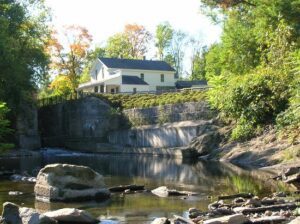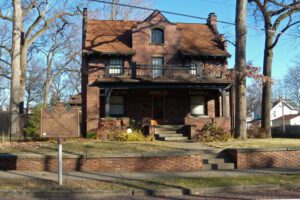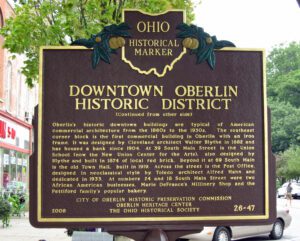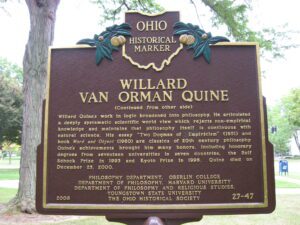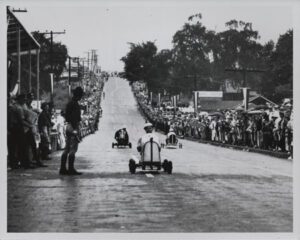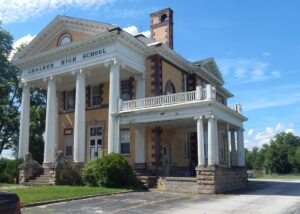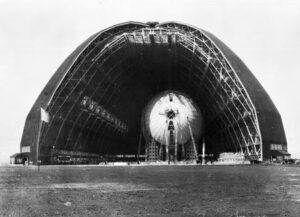, OH
The Mustill house and store are survivors of Akron’s canal era and date to the 1840s. Joseph and Sarah Mustill moved their family from England to Akron in 1833 and owned the store and Greek Revival house at Lock 15 on the Ohio & Erie Canal. Three generations of Mustills lived and worked the grocery business at Lock 15, first Joseph and Sarah, then their son Fred with his wife Emma, and their children Maria, Frederick, Edwin and Franklin. A popular place to buy or barter goods, the store served canallers, farmers, craftsmen, and neighbors for many years.
, OH
Industrialist and entrepreneur Franklin Augustus Seiberling (1859-1955) named his fledgling rubber goods manufacturing company “Goodyear” to honor Charles Goodyear, the man who invented the vulcanization process for curing rubber. Seiberling founded the company with his brother, Charles Willard, because of their desire to participate in an enterprise that afforded an “opportunity for invention.” Incorporated in 1898, Goodyear Tire and Rubber Company rapidly grew with the young automotive industry and helped establish Akron as the “Rubber Capital of the World.” Among Seiberling’s many significant inventions were the tire-making machine and the detachable wheel rim. He resigned from Goodyear in 1921 and went on to found the Seiberling Rubber Company. Stan Hywet Hall, F.A. Seiberling’s estate in west Akron, is a National Historic Landmark.
, OH
Akron, an industrial boomtown in the early twentieth century, grew in population nearly fivefold between 1900 and 1920. As the city industrialized, middle class residents sought homes on West Hill, away from the smoke and soot of heavy industry on the East Side. The Hall Park Allotment Historic District in West Hill represents a notable early twentieth century neighborhood. Developed by Philander Hall between 1902 and 1919 during the height of Akron’s “rubber boom,” it consists of several houses representing the picturesque styles of the period, including the American Foursquare, Craftsman, Colonial, and Medieval Revival Styles. With its gently curving brick streets, hilly topography, and mature trees, the Hall Park Allotment Historic District evokes the feeling of a distinct period of time in Akron’s history and constitutes a neighborhood of distinctive historical character and architectural merit.
, OH
The intersection of Main and College streets has been the center of Oberlin since the town and college were founded in 1833. The first downtown buildings were made of wood and were destroyed by a series of spectacular fires. The first college building, Oberlin Hall, stood on the southwest corner of College and Main and included recitation rooms, a dining hall, chapel, offices, and lodging. In 1887, Akron architect Frank Weary designed the large brick building at numbers 5 to 13 West College. Number 23 West College (Gibson Block) once housed a silent movie theater on the second floor. East College Street’s historic buildings include the Apollo Theater, which showed Oberlin’s first talking movie on May 11, 1928. From 1897 to 1929, an interurban streetcar line connected Oberlin’s downtown to Cleveland. Oberlin’s downtown historic district was placed on the National Register of Historic Places in 2003.
, OH
Willard Van Orman Quine was one of the greatest philosophers and logicians of the 20th century. Born in Akron on June 25, 1908, Quine studied philosophy and logic at Oberlin College (B.A. 1930). He received his Ph.D. in philosophy from Harvard University in 1932 and spent his entire career on the Harvard faculty, from 1956 to 1978 as Edgar Pierce Professor of Philosophy. Quine’s early research in logic led to his New Foundations system of set theory and to the Quine-McCluskey algorithm, used in computer science. His textbook Methods of Logic established the standards for undergraduate logic instruction. (Continued on other side)
, OH
An annual summer tradition for American youth since the 1930s, the All-American Soap Box Derby was the concept of journalist Myron E. (“Scottie”) Scott, who covered an impromptu homebuilt gravity-car race in Dayton in 1933. Scott conceived and promoted a prize-awarding event later that year, and to his surprise 362 boys entered the race. Restrictions on material cost and participants’ ages widened the sport’s appeal; the Soap Box Derby held its first national championship in Akron in 1935, sponsored by the auto and rubber industries. Derby Downs, built as a public works project by the New Deal-era Works Progress Administration (WPA), has been the event’s home since 1936. The Soap Box Derby continues to promote the values of craftsmanship, sportsmanship, and perseverance for generations of American youth.
, OH
Southington native Newton Chalker built, furnished, and donated Chalker High School to his community in 1907. Chalker was born in 1842 in Southington Township and lived there until adulthood. He later built a prosperous law and real estate practice in Akron. Chalker’s dedication to improve educational opportunities in the township likely originated with his personal struggle to complete high school, which was repeatedly interrupted by financial concerns and family obligations. The Chalker High School building was designed in the Neo-Classical Revival architectural style which was favored for public buildings, churches and schools early in the twentieth century. The building exhibits Classical influences through the use of fluted columns that support a pedimented gable, resembling a Greek temple. Chalker High School and the Civil War Monument were listed in the National Register of Historic Places in 2010. (Continued on other side)
, OH
A colossus of engineering acumen and structural steel, the Airdock was built in 1929 as the construction facility for the U.S. Navy’s rigid airships, the USS Akron (1931) and USS Macon (1933). The airships, or dirigibles, served as the fleet’s aerial watchdogs, but with the advancement of aircraft carriers, the Navy no longer needed these leviathans of the skies, which were large enough to carry five biplanes. Eleven steel parabolic arches, cresting at 211 feet, create one of the largest open space interiors in the world and shelter more than 364,000 square feet of floor space. Only one of the arches is fixed to its concrete piling. Its 660-ton spherical doors rest on flatbed railroad cars to open. The Airdock, a National Civil Engineering Landmark, was added to the National Register of Historic Places in 1973.


